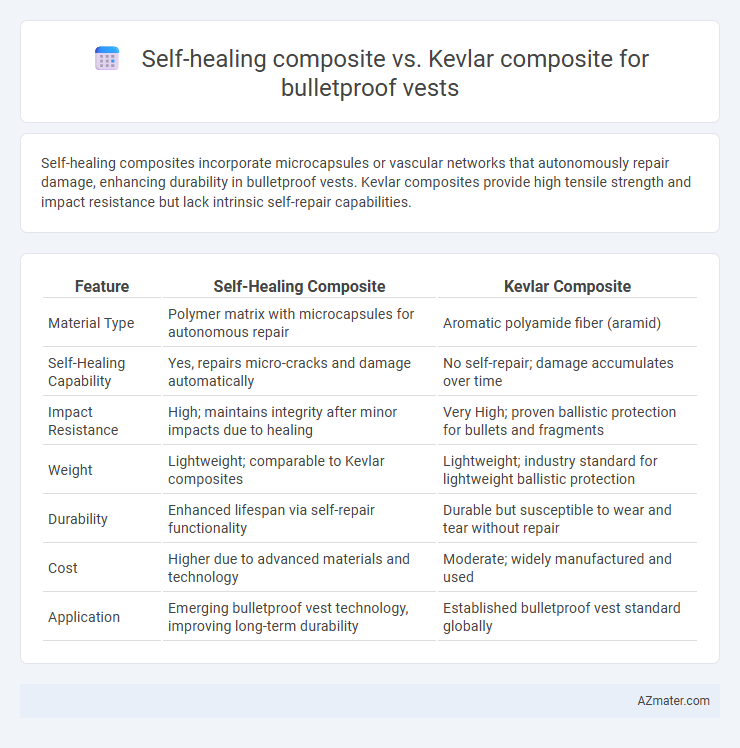Self-healing composites incorporate microcapsules or vascular networks that autonomously repair damage, enhancing durability in bulletproof vests. Kevlar composites provide high tensile strength and impact resistance but lack intrinsic self-repair capabilities.
Table of Comparison
| Feature | Self-Healing Composite | Kevlar Composite |
|---|---|---|
| Material Type | Polymer matrix with microcapsules for autonomous repair | Aromatic polyamide fiber (aramid) |
| Self-Healing Capability | Yes, repairs micro-cracks and damage automatically | No self-repair; damage accumulates over time |
| Impact Resistance | High; maintains integrity after minor impacts due to healing | Very High; proven ballistic protection for bullets and fragments |
| Weight | Lightweight; comparable to Kevlar composites | Lightweight; industry standard for lightweight ballistic protection |
| Durability | Enhanced lifespan via self-repair functionality | Durable but susceptible to wear and tear without repair |
| Cost | Higher due to advanced materials and technology | Moderate; widely manufactured and used |
| Application | Emerging bulletproof vest technology, improving long-term durability | Established bulletproof vest standard globally |
Introduction: The Evolution of Bulletproof Vest Materials
Self-healing composites represent a significant advancement over traditional Kevlar composites in bulletproof vest technology, offering enhanced durability and extended service life through autonomous damage repair mechanisms. Kevlar composites, known for their high tensile strength and energy absorption, have been the industry standard for ballistic protection but are prone to irreversible damage upon impact. The evolution towards self-healing materials integrates microcapsules or vascular networks within the composite matrix, enabling the restoration of structural integrity after ballistic events, which marks a transformative shift in personal protective equipment design.
What Are Self-Healing Composites?
Self-healing composites are advanced materials engineered to autonomously repair damage such as cracks or punctures, enhancing the durability and lifespan of bulletproof vests. These composites typically incorporate microcapsules or vascular networks that release healing agents when the material is compromised. Compared to Kevlar composites, which rely solely on high tensile strength fibers to absorb and dissipate energy, self-healing composites offer the additional benefit of restoring structural integrity after impact, potentially increasing safety and reducing maintenance costs.
Overview of Kevlar Composites
Kevlar composites are renowned for their exceptional tensile strength and lightweight properties, making them a preferred material in bulletproof vest manufacturing. These composites consist of Kevlar fibers embedded in a resin matrix, providing high impact resistance and energy absorption capabilities. Their widespread use in personal armor stems from their proven effectiveness in stopping bullets while maintaining flexibility and durability.
Strength and Ballistic Resistance Comparison
Self-healing composites exhibit advanced damage recovery properties that enhance durability and extend the lifespan of bulletproof vests by autonomously repairing micro-cracks, whereas Kevlar composites rely on high tensile strength and fiber interlocking to absorb and disperse ballistic energy. Kevlar composites maintain superior immediate ballistic resistance due to their proven multi-layer fiber architecture, effectively stopping high-velocity projectiles with consistent performance. The integration of self-healing polymers in composite matrices shows promise in maintaining ballistic integrity over repeated impacts, potentially surpassing Kevlar in long-term protective strength and reducing maintenance frequency.
Durability and Longevity Analysis
Self-healing composites in bulletproof vests offer enhanced durability by autonomously repairing micro-cracks and damage, extending the lifespan compared to traditional Kevlar composites. Kevlar composites provide high tensile strength and proven ballistic resistance but degrade over time due to repeated impacts without self-repair capabilities. The integration of self-healing polymers in composites results in higher longevity through sustained structural integrity and reduced maintenance requirements under operational conditions.
Weight and Comfort Differences
Self-healing composites in bulletproof vests exhibit a significant advantage in weight reduction, often weighing up to 30% less than traditional Kevlar composites due to their ability to repair micro-damages autonomously. This weight difference directly enhances wearer comfort by reducing fatigue during prolonged use and improving mobility. Kevlar composites, although highly durable, tend to be heavier and stiffer, potentially compromising long-term comfort and flexibility compared to the lighter, more adaptive self-healing materials.
Repairability and Maintenance Insights
Self-healing composites in bulletproof vests offer significant advantages in repairability by autonomously sealing micro-cracks and damage without external intervention, enhancing long-term durability compared to Kevlar composites. Kevlar composites require manual repairs or full replacement after sustaining impact damage, increasing maintenance costs and downtime. The integration of self-healing polymers reduces the frequency of repairs and prolongs the service life, making them more cost-effective and reliable for continuous ballistic protection.
Cost and Manufacturing Considerations
Self-healing composites present higher initial costs due to advanced polymer matrix integration and specialized manufacturing processes, whereas Kevlar composites benefit from established, cost-effective mass production techniques. Manufacturing self-healing composites requires precise curing cycles and incorporation of microcapsules or vascular networks, increasing complexity and production time compared to the straightforward layering and weaving in Kevlar fabrication. Cost-efficiency in Kevlar composites remains superior for large-scale bulletproof vest manufacturing, while self-healing composites potentially reduce long-term maintenance expenses by autonomously repairing damage.
Applications in Military and Law Enforcement
Self-healing composites in bulletproof vests offer enhanced durability and extended service life by autonomously repairing micro-damage caused during ballistic impacts, reducing the need for frequent replacements in military and law enforcement operations. Kevlar composites, renowned for their high tensile strength and proven ballistic resistance, provide reliable protection against projectiles but lack autonomous repair capabilities, often necessitating prompt vest replacement to maintain safety standards. Integrating self-healing technology in bulletproof vests can revolutionize protective gear used by soldiers and police officers by maintaining structural integrity and performance in demanding field conditions.
Future Trends in Bulletproof Vest Materials
Self-healing composites, incorporating microcapsules or vascular networks to autonomously repair damage, represent a significant advancement over traditional Kevlar composites by enhancing durability and extending the lifespan of bulletproof vests. Future trends in bulletproof vest materials emphasize multifunctionality, combining high-impact resistance, lightweight properties, and self-healing capabilities to improve user safety and comfort. Research continues to explore nanomaterials and polymer blends integrated with self-healing mechanisms, aiming to surpass the mechanical limitations of Kevlar while maintaining or reducing overall vest weight.

Infographic: Self-healing composite vs Kevlar composite for Bulletproof vest
 azmater.com
azmater.com